Physical Address
304 North Cardinal St.
Dorchester Center, MA 02124
Physical Address
304 North Cardinal St.
Dorchester Center, MA 02124
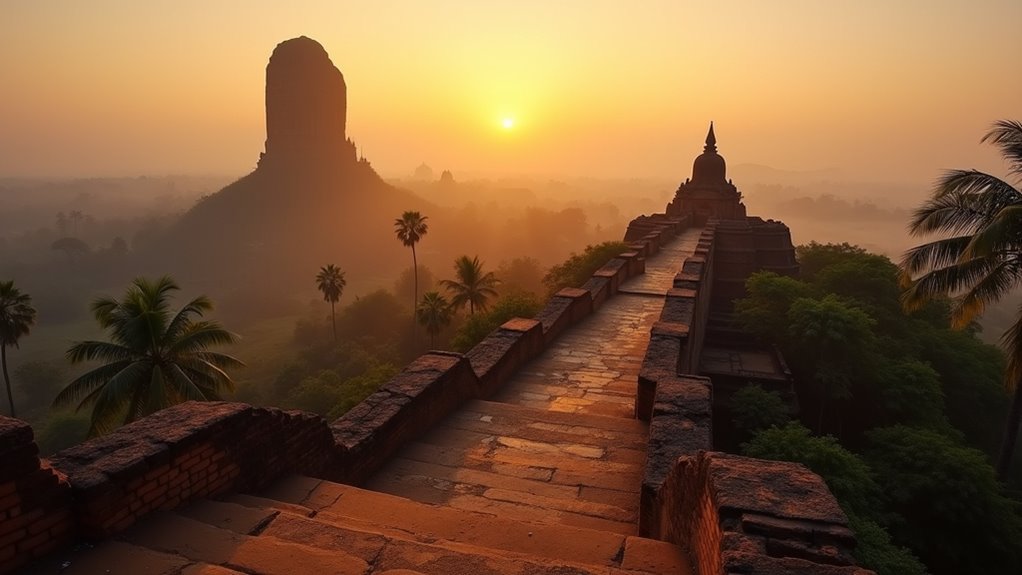
Numerous ancient wonders await in Sri Lanka's landscape, from sacred temples to colonial fortresses—but which ones truly captivate visitors?
Sri Lanka’s historical treasures span ancient capitals to colonial fortresses. Don’t miss Anuradhapura’s Buddhist ruins, Sigiriya’s dramatic rock fortress, and Kandy’s sacred Temple of the Tooth. Explore Polonnaruwa’s medieval splendor, Dambulla’s cave temples, and Galle’s Dutch-colonial fort. Complete your journey with Sinharaja’s biodiversity, the misty tea plantations of the Central Highlands, and the interconnected wonders of the Cultural Triangle. Each site offers a unique window into the island’s opulent 2,500-year heritage.
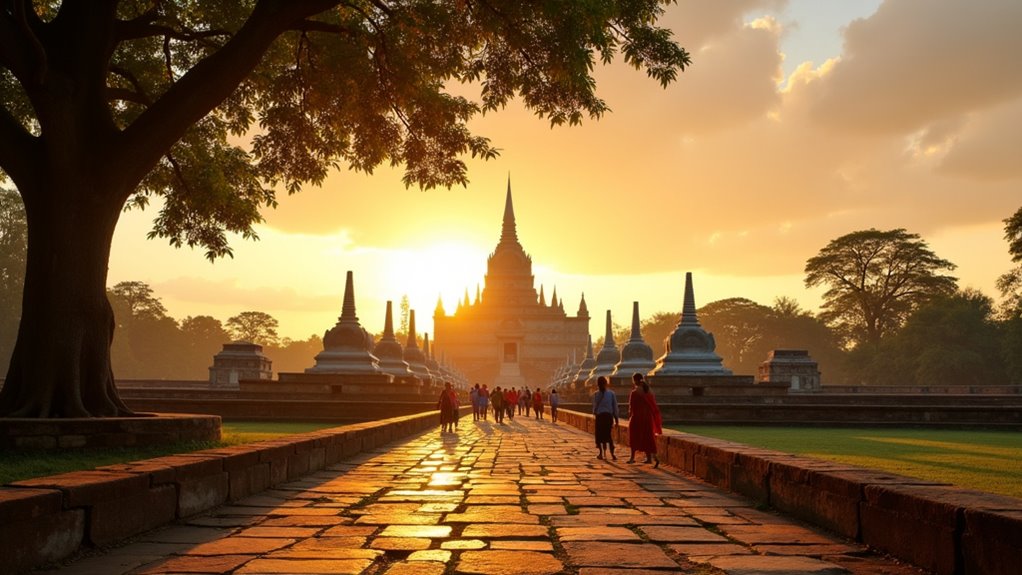
When you visit the Ancient City of Anuradhapura, you’re walking through Sri Lanka’s first capital—a remarkable urban center that shaped the island’s identity for over 1,500 years. Founded in the 5th century BCE, this UNESCO World Heritage Site was once among Asia’s largest cities.
You’ll be amazed by the massive stupas like Ruwanwelisaya and Jetavanarama that dominate the sacred area. Don’t miss the Jaya Sri Maha Bodhi, a sacred fig tree believed to be grown from a cutting of the original tree under which Buddha attained enlightenment. Despite Chola invasions in the 11th century that shifted political power to Polonnaruwa, Anuradhapura never lost its religious significance.
Located about 205km north of Colombo, it’s essential for understanding Sri Lanka’s ancient civilization. As you explore the extensive ruins of temples and monasteries, you’re experiencing one of the world’s greatest Buddhist monastic sites—a living record to Sinhalese culture.
Rising dramatically from the central plains of Sri Lanka, Sigiriya Rock Fortress stands as another testament to the island’s abundant ancient heritage. Built by King Kashyapa between 477-485 AD as a stronghold against his brother’s invasion, this UNESCO World Heritage Site soars 600 feet above the landscape.
Like an ancient sentinel guarding Sri Lanka’s secrets, Sigiriya Rock Fortress towers majestically over the verdant plains below.
You’ll climb 1,270 steps to reach the summit where a palace once stood, so arrive early to avoid crowds and heat. The journey upward reveals remarkable engineering feats, including ornate gardens and well-preserved ruins. The site showcases some of the oldest landscaped gardens in the world, divided into distinct water, boulder, and terraced sections.
After King Kashyapa’s death in battle in 491 AD, Buddhist monks inherited the site.
Don’t miss exploring the surrounding gardens by bicycle for a more immersive experience. This volcanic rock inselberg isn’t called the eighth wonder of the world without reason!
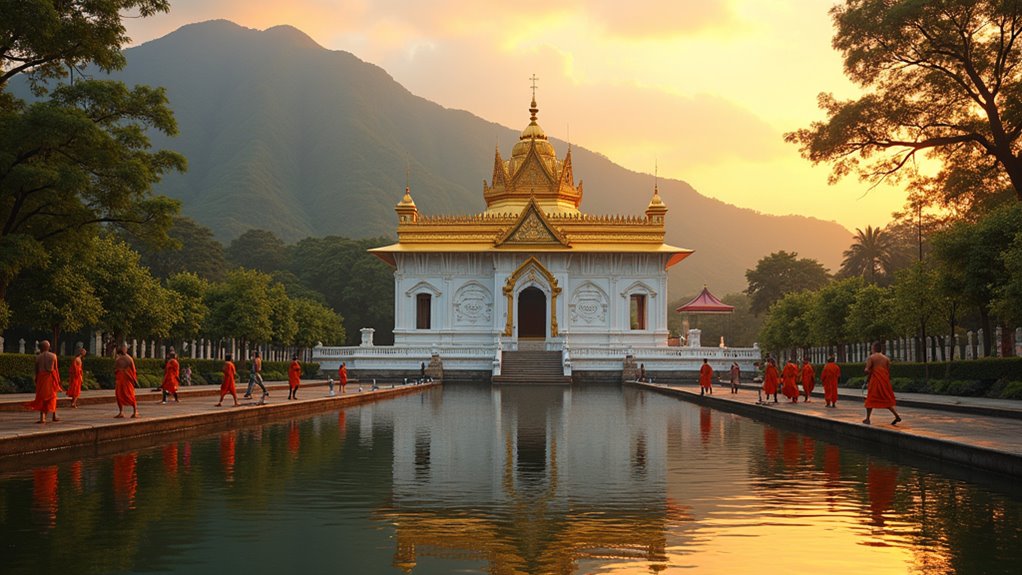
Nestled among verdant hills in central Sri Lanka, the sacred city of Kandy calls visitors with its affluent historical tapestry and spiritual significance. As the country’s capital in the 16th century, this strategic stronghold successfully resisted colonial powers for centuries.
You’ll find the Temple of the Tooth at Kandy’s heart, housing Buddha’s sacred tooth relic. Built around 1600 by King Vimaladharmasuriya I and now a UNESCO World Heritage Site, it’s a must-visit pilgrimage destination for Buddhists worldwide. The sacred relic was originally brought to Sri Lanka by Princess Hemamali who concealed it in her hair during the perilous journey from Kalinga.
Don’t miss the spectacular Esala Perahera festival if you’re visiting in July or August. After exploring the temple’s intricate Sinhalese architecture and surrounding shrines, take time to wander along Kandy Lake and browse local marketplaces for authentic handicrafts and cuisine.
Ancient Polonnaruwa stands as a proof to Sri Lanka’s medieval golden age, where crumbling palaces and towering Buddha statues tell stories of a civilization at its zenith.
You’ll be awestruck by the UNESCO-protected ruins, especially the Gal Vihara with its massive Buddha statues carved from a single granite wall. Don’t miss the sophisticated bathing pools and remarkable irrigation systems—some still functioning after nearly a millennium!
When visiting, start at the museum near the entrance to understand the city’s 12th-century peak under King Parakramabahu I. The massive Parakrama Samudra reservoir showcases the engineering prowess that sustained this medieval capital for three centuries. After Anuradhapura’s destruction in 993, Polonnaruwa became the second capital city of Sri Lanka and flourished as a religious and political center.
For the best experience, hire a guide to reveal the cultural exchange between Chola and Sinhalese civilizations evident in every stone carving.
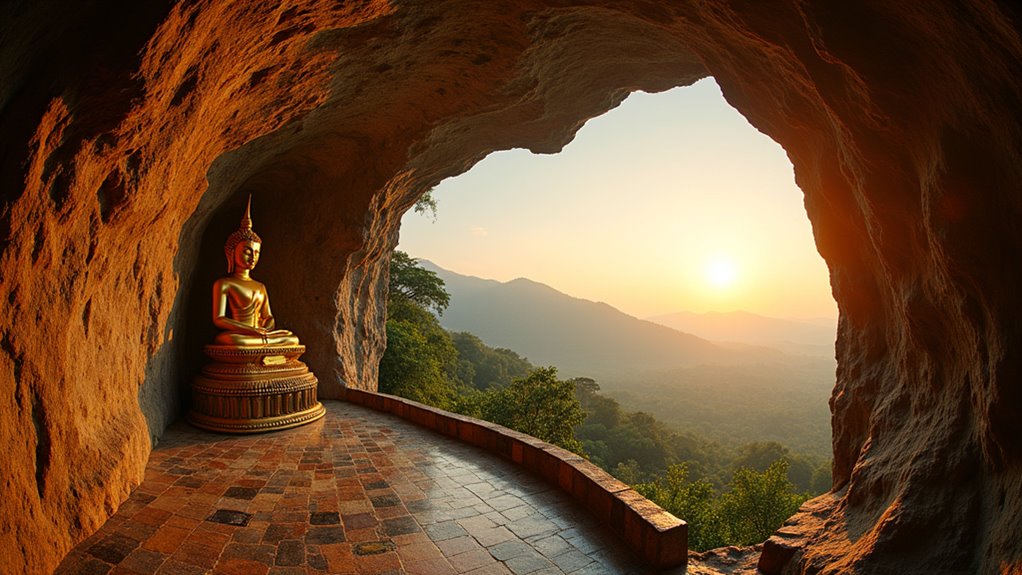
Carved into a massive rock face nearly 1,100 feet above sea level, the Golden Temple of Dambulla enthralls visitors with its five sacred caves that have served as a Buddhist sanctuary since the 1st century BCE. You’ll be walking through living history as you explore this UNESCO site, originally established by King Vattagamini Abhaya.
Don’t miss the intricate Kandyan-style murals that adorn the cave ceilings, following the natural rock contours. The numerous Buddha statues, including those gilded by King Nissanka Malla, showcase centuries of artistic development. The site houses an impressive collection of 157 statues of religious significance throughout the five sanctuaries.
As you wander through the arched colonnades added in 1938, you’ll appreciate why this remains one of Sri Lanka’s best-preserved ancient sites and continues to function as an important pilgrimage destination after 22 centuries.
Standing majestically at the southwestern tip of Sri Lanka, Galle Fort represents one of the most fascinating examples of colonial heritage in South Asia. You’ll be walking through living history as you explore this UNESCO World Heritage Site, founded by Portuguese in 1588 and expanded by Dutch settlers.
Stroll along narrow streets lined with Dutch colonial buildings and shaded verandas, where European urban planning blends seamlessly with South Asian elements. Don’t miss Flag Rock Bastion for spectacular coastal views and a glimpse of the fort’s strategic importance. The fort’s impressive architecture includes the historic Zwart Bastion, which stands as the oldest fortification within the complex.
What makes Galle truly special is its living heritage—residents still inhabit these historic structures, maintaining cultural continuity within massive coral and granite ramparts. The 17th-century drainage system remains functional, testament to Dutch engineering excellence that’s withstood centuries.
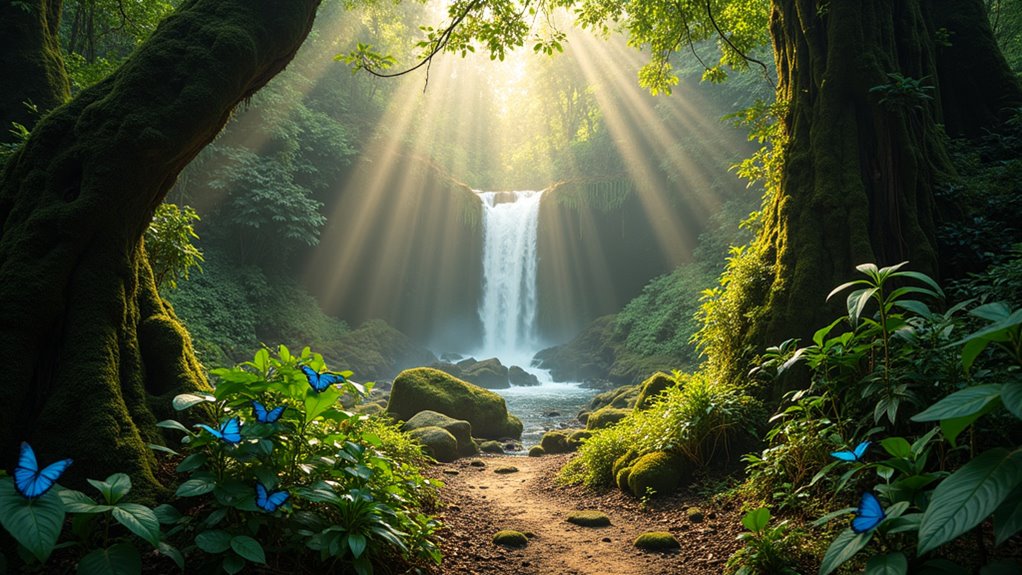
Deep in the southwest lowlands of Sri Lanka lies a natural wonder that few travelers fully appreciate. Spanning nearly 9,000 hectares, Sinharaja isn’t just a forest—it’s a UNESCO World Heritage site teeming with life you won’t find anywhere else on Earth.
You’ll discover why conservationists treasure this place: over 60% of the trees are endemic to Sri Lanka, and you’ll spot birds, mammals, and butterflies found nowhere else. The purple-faced leaf monkey and Sri Lankan blue magpie might grace your visit if you’re lucky.
Don’t miss the guided walks that support local communities while offering authentic glimpses into this ecological sanctuary. As you traverse the network of streams feeding the Gin and Kalu rivers, you’re experiencing one of the world’s most precious biodiversity hotspots. This ancient rainforest represents a living relic of Gondwanaland flora, providing scientists valuable insights into continental drift and evolutionary processes.
Nestled above the humid lowlands, Sri Lanka’s Central Highlands offer an invigorating escape where misty mountains cradle emerald tea plantations as far as the eye can see.
A lush green sanctuary where mist-kissed mountains embrace endless waves of Ceylon’s finest tea leaves.
You’ll find yourself stepping into the legacy of Ceylon tea, pioneered by James Taylor in 1867 at Loolecondera Estate. The industry expanded dramatically after coffee rust disease devastated coffee plantations in the late 1860s, creating an opportunity for tea to become Sri Lanka’s premier crop. Don’t miss the Ceylon Tea Museum near Kandy to understand the region’s transformative industry.
For breathtaking views, head to World’s End at Horton Plains or take the scenic railway from Kandy to Nuwara Eliya.
Between tea tastings, explore Adam’s Peak‘s cultural significance or hike the Knuckles Mountain Range. The region’s unique blend of British colonial influence and Sri Lankan heritage is evident in everything from architecture to the traditional afternoon tea ritual still practiced today.
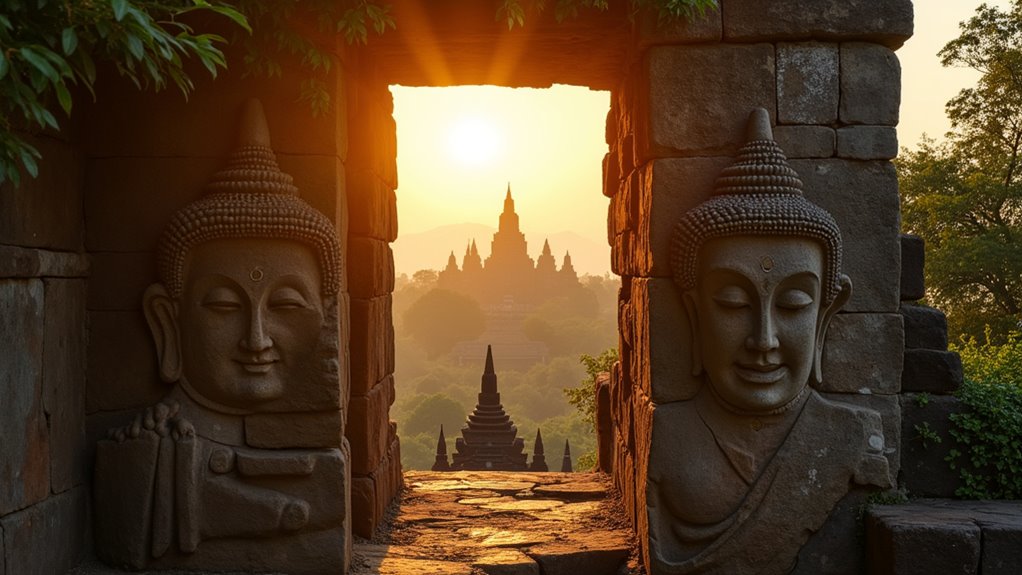
Located at the heart of Sri Lanka’s affluent cultural landscape, the Cultural Triangle forms an essential historical circuit connecting the ancient capitals of Anuradhapura, Polonnaruwa, and Kandy. This UNESCO-rich region offers a fascinating glimpse into the island’s ancient civilizations and architectural marvels.
For an unforgettable Cultural Triangle experience:
Don’t miss Sigiriya’s majestic rock fortress, Dambulla’s colorful cave temples, and the lesser-known Ritigala monastery for a more secluded adventure. The optimal months for visiting are January to March when you can enjoy dry, sunny weather that enhances your sightseeing experience.
As you’re packing for Sri Lanka, don’t forget that extra memory card—you’ll need it when you’re snapping selfies with 2,000-year-old Buddhas and colonial forts. You’ve now got nine historical gems to explore, but let’s be honest, you’ll probably spend half your trip stuck behind a tour bus of retirees. Still, these ancient wonders are worth every sweaty, sunburned minute!